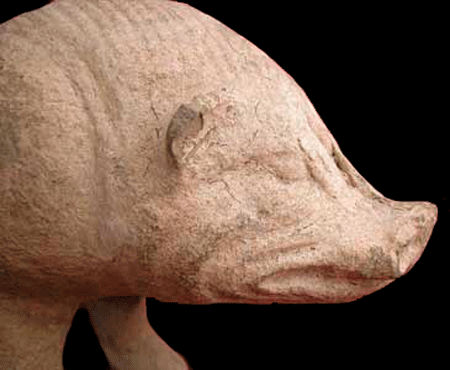Eastern Han Terracotta Sculpture of a Boar, 23 CE - 220 CE
Terracotta
6
H.639
The Han Dynasty, like the Zhou before it, is divided into two distinct periods, the Western Han (206 B.C.-9 A.D.) and the Eastern Han (23-220 A.D.) with a brief interlude....
The Han Dynasty, like the Zhou before it, is divided into two distinct periods, the Western Han (206 B.C.-9 A.D.) and the Eastern Han (23-220 A.D.) with a brief interlude. Towards the end of the Western period, a series of weak emperors ruled the throne, controlled from behind the scenes by Wang Mang and Huo Guang, both relatives of empresses. They both exerted enormous influence over the government and when the last emperor suddenly passed away, Mang became ruling advisor, seizing this opportunity to declare his own Dynasty, the Xin, or “New.” However, another popular uprising began joined by the members of the Liu clan, the family that ruled the Han Dynasty, the Xin came to a quick end and the Eastern Han was established in its place with its capital at Loyang (Chang’an, the capital of the Western Han, was completely destroyed).
However, even as Chinese influence spread across Southeastern Asia into new lands, the Eastern Han Dynasty was unable to recreate the glories of the Western Period. In fact, this period can be characterized by a bitter power struggle amongst a group of five consortial clans. These families sought to control the young, weak emperors with their court influence. Yet, as the emperors became distrustful of the rising power of the clans, they relied upon their eunuchs to defend them, often eliminating entire families at a time. During the Western Han, the Emperor was viewed as the center of the universe. However, this philosophy slowly disintegrated under the weak, vulnerable rulers of the Eastern Han, leading many scholars and officials to abandon the court. Eventually, the power of the Han would completely erode, ending with its dissolution and the beginning of the period known as the “Three Kingdoms.”
Sculptures of pigs are frequently buried alongside noble members of society during the Han Dynasty. Sculpted in all media, the pig was a symbol of wealth as well as a staple of the menu for the afterlife. As was the custom, sculpted effigies of animals were interred as food sources in the next world. While some animals were meant to labor in the next world, others, such as this boar, were clearly meant for consumption. The Han viewed the afterlife as an extension of our earthly lives. Thus, the things that we enjoyed in this world were continually enjoyed in the next. Likewise, as humans require food to nourish and sustain us while on earth, sculpted animals were buried to provide energy in the afterlife. This standing boar appears to comprehend his role in the afterlife. His snarling mouth with subtly suggested fangs reveals his reluctance to be anybody’s meal. In fact, the facial structure of this boar is quite reminiscent of snarling terracotta dog sculptures that served the same function. The defined musculature of the beast further emphasizes his power. However, it is this power that will be transferred to the deceased through the symbolic consumption of his “meat.” Originally, this boar was created to provide sustenance in the next world. However, today, it nourishes our eyes with its tremendous beauty and fills our minds with its tremendous cultural and historical value.
However, even as Chinese influence spread across Southeastern Asia into new lands, the Eastern Han Dynasty was unable to recreate the glories of the Western Period. In fact, this period can be characterized by a bitter power struggle amongst a group of five consortial clans. These families sought to control the young, weak emperors with their court influence. Yet, as the emperors became distrustful of the rising power of the clans, they relied upon their eunuchs to defend them, often eliminating entire families at a time. During the Western Han, the Emperor was viewed as the center of the universe. However, this philosophy slowly disintegrated under the weak, vulnerable rulers of the Eastern Han, leading many scholars and officials to abandon the court. Eventually, the power of the Han would completely erode, ending with its dissolution and the beginning of the period known as the “Three Kingdoms.”
Sculptures of pigs are frequently buried alongside noble members of society during the Han Dynasty. Sculpted in all media, the pig was a symbol of wealth as well as a staple of the menu for the afterlife. As was the custom, sculpted effigies of animals were interred as food sources in the next world. While some animals were meant to labor in the next world, others, such as this boar, were clearly meant for consumption. The Han viewed the afterlife as an extension of our earthly lives. Thus, the things that we enjoyed in this world were continually enjoyed in the next. Likewise, as humans require food to nourish and sustain us while on earth, sculpted animals were buried to provide energy in the afterlife. This standing boar appears to comprehend his role in the afterlife. His snarling mouth with subtly suggested fangs reveals his reluctance to be anybody’s meal. In fact, the facial structure of this boar is quite reminiscent of snarling terracotta dog sculptures that served the same function. The defined musculature of the beast further emphasizes his power. However, it is this power that will be transferred to the deceased through the symbolic consumption of his “meat.” Originally, this boar was created to provide sustenance in the next world. However, today, it nourishes our eyes with its tremendous beauty and fills our minds with its tremendous cultural and historical value.



